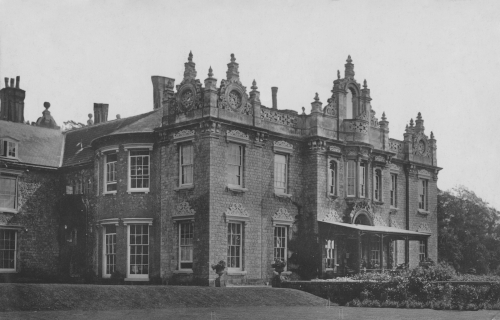Vinters
Kent
| Location | Maidstone | ||
| Year demolished | 1956 | ||
| Reason | Fire, following neglect during WWII | ||
| See all images: | Gallery | ||
| << Back to the main list |
Vinters House, once a grand country estate in north-east Maidstone, has a long and eventful history stretching back to the medieval period. Though now largely lost to development, the estate’s legacy endures in the remnants of its parkland and the Vinters Valley Nature Reserve.
The Williamson family
Origins and medieval ownership Archaeological evidence suggests Roman activity on the site, but the first recorded history of Vinters House begins in 1343, when Roger de Vinter purchased the land from the Abbot of Boxley. He built the first house and established a park, giving his name to the estate.
Archaeological evidence suggests Roman activity on the site, but the first recorded history of Vinters House begins in 1343, when Roger de Vinter purchased the land from the Abbot of Boxley. He built the first house and established a park, giving his name to the estate.
Over the centuries, Vinters changed hands multiple times. One of its most infamous owners was Henry Isley, who took part in Sir Thomas Wyatt the Younger’s Rebellion against Queen Mary I in 1554. Following the rebellion’s failure, Isley was executed, and his property was seized by the Crown. Queen Mary later granted the estate to Henry Cutts of Bynbury.
The Whatman Era: 18th- and 19th-century transformation
After passing through various owners, Vinters House was acquired by James Whatman of Vinters in the late 18th century. His father, James Whatman the Elder, had built a prosperous business in papermaking through Turkey Court Paper Mill, but it was his son who took residence at Vinters. In 1782, James Whatman of Vinters moved into the estate, having purchased it from Lord Ongley. By then, the estate spanned 86 acres, and he invested significantly in improvements, spending £5,000 on renovations.In 1797, following his retirement due to a stroke, Whatman expanded his holdings by purchasing Newnham Court Farm and additional local properties. That same year, he commissioned the renowned landscape gardener Humphry Repton to redesign Vinters’ parkland. Repton’s proposed modifications, documented in one of his signature Red Books (now held at the Yale Centre for British Art), sought to enhance the estate’s natural beauty. His design included a meandering green valley, a large ornamental pool, and the removal of visible farmland near the house to create a more secluded and picturesque setting.
Sadly, Whatman did not live to see Repton’s vision fully realised. He died in 1798 at the age of 57 and was buried at Boxley Church. The estate passed to his son, also named James, who continued the family’s legacy.
In 1852, the estate was inherited by James Whatman IV, who significantly expanded Vinters House. He added a dairy, brew-house, still room, larder, servants’ hall, pantry, study, and bathroom. The estate also boasted an icehouse, a boathouse, a walled kitchen garden with heated glasshouses, and extensive stables. Under his stewardship, Vinters became one of the finest country houses in Kent.
Decline and Demolition
Following James Whatman IV’s death in 1887, his widow remained at Vinters until 1905. Ownership then passed through the Whatman daughters, with the last family member, Miss Louisa Whatman, dying in 1950 at the age of 92. However, she had not resided at Vinters for many years, preferring to live at Newnham Court while renting out the estate.During World War II, Vinters House was requisitioned for military use. The estate housed Army personnel, with ATS (Auxiliary Territorial Service) women stationed in the main house and male soldiers in billets near the kitchen garden. While the fine furniture and valuables were secured, the estate saw significant wear and tear during the war years.
After the war, the house stood empty for several years before the entire 660-acre estate was sold in 1956 to local property developer Percy Barden. Soon after, the house was largely destroyed by fire and subsequently demolished in 1956. The former estate lands were redeveloped, with Vinters housing estate built on the hop gardens and wheat fields, and Grove Green covering the old market gardens. Parts of the parkland became school playing fields, Maidstone TV Studios, and Vinters Park Crematorium.
Preserving Vinters’ legacy
The remnants of Vinters estate fell into neglect until local campaigners Donal and Lida MacGrory led efforts to preserve what was left. Their persistence resulted in Kent County Council acquiring the land that later became Vinters Valley Nature Reserve. The reserve, officially designated in 1992, now covers 90 acres and preserves elements of the former estate, including the ha-ha, the barrel bridge, and the icehouse, which now serves as a bat roost.Thanks to conservation efforts, visitors today can still glimpse echoes of Vinters House’s illustrious past while enjoying the natural beauty of the reserve.